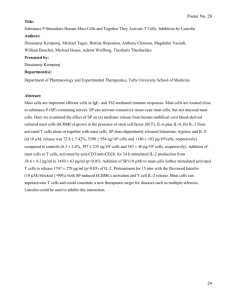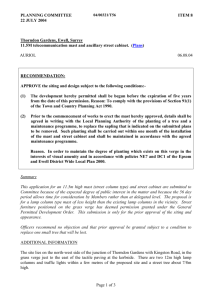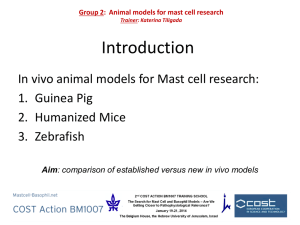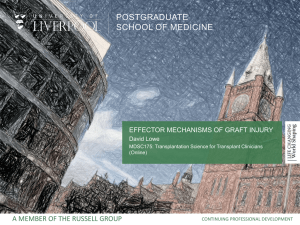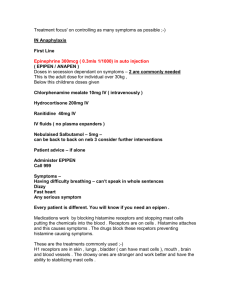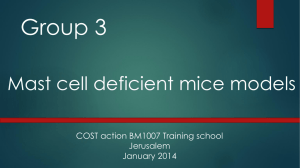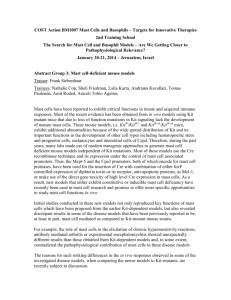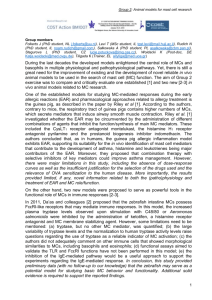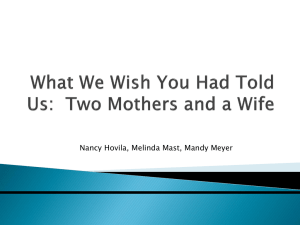Group_6_Presentation - Mast Cell
advertisement
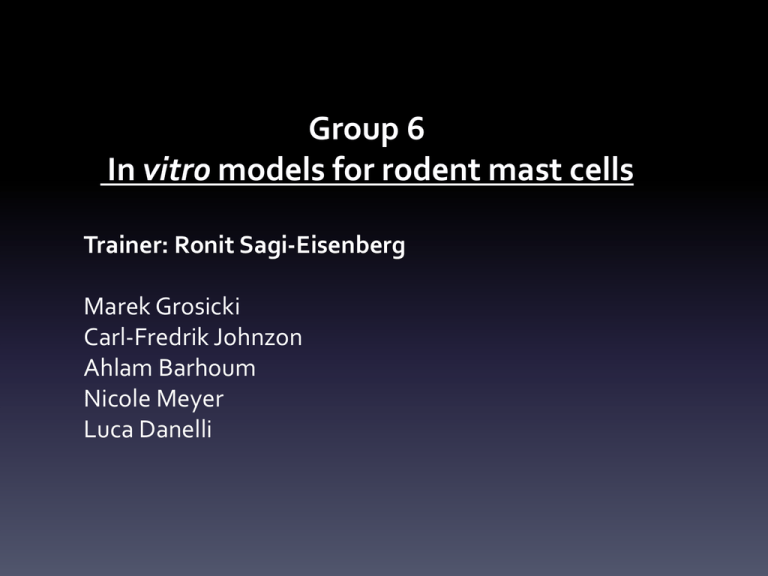
Group 6 In vitro models for rodent mast cells Trainer: Ronit Sagi-Eisenberg Marek Grosicki Carl-Fredrik Johnzon Ahlam Barhoum Nicole Meyer Luca Danelli In vitro strategies for rodent mast cells culture Ex vivo isolation from tissues – tissue homogenization and separation steps affect MC activation – low cell yields Peritoneal Mast Cells – easily to obtain but further purification can affect activation response Bone marrow or blood-derived Mast cells – long culture time, difference between in vivo and in vitro derived cells RBL, MCBS1 – cell lines with high homogeneity, marginally representative of mature, tissue bound mast cells In vitro strategies for rodent mast cells culture Ex vivo isolation from tissues – tissue homogenization and separation steps affect MC activation – low cell yields Peritoneal Mast Cells – easily to obtain but further purification can affect activation response Bone marrow or blood-derived Mast cells – long culture time, difference between in vivo and in vitro derived cells RBL, MCBS1 – cell lines with high homogeneity, marginally representative of mature, tissue bound mast cells Heterogenous cell cultures of peritoneal cells (3% mast cells, 30% macrophages, 55% B cells, 7% T cells) Method: • Peritoneal lavage (complete media) • Plated on fibroblasts • Cultured overnight (with IgE) Mast cells activation (IgE/Ag) • • • • Heterogenous vs homogenous Time Concentration Species differences • More “realistic” ex vivo microenvironment But.. Difficulties to dissect MC behavior and single cell population contribution in the heterogeneous cell cultures Background Activating mutations in KIT are associated with specific disease states such as mastocytosis and gastrointestinal stromal cell tumors. Aim Definition of functional MC line which doesn’t express native KIT and which would facilitate the examination of human KIT Methods Detection of a rapidly proliferating MC population from mTOR knock/in mice (mTOR transcription disruption). Replicating BMMCs lose kit expression Reconstitution with huKIT Chemotactic and degranulation response to huSCF Advantages • Screening and identifying potential novel inhibitors of KIT and potentially mutated KIT signaling capacity Limitations • mTOR regulates fundamental physiologic functions, including nutrient sensing ,metabolism, cell growth, proliferation, and migration … relevance in molecular pathways in MC biology? • Investigating human receptor functionality in a murine model Munc18 protein in mast cell exocytosis model Exocytosis: energy-consuming process by which a cell directs the contents of secretory vesicles out of the cell membrane and into the extracellular space. SNARE protein SNARE protein complex: -SYNTAXIN - SNAP-25 - VAMP complex Munc18 protein: Family of proteins that play multiple functions: - Chaperoning cognate syntaxin - Priming/stimulating membrane fusion, interacting with SNARE complex • • Patients with familial hemophagocytic lymphohistiocytosis (FHL) types 3, 4, and 5 identified mutations in Munc13-4, syntaxin-11, and Munc18Markedly reduced degranulation of lytic granules in cytotoxic T lymphocytes (CTLs), natural killer (NK) cells, and platelets. Disrupted degranulation of mast cells and neutrophils? Stimulation with DNP-HSA Model RBL2H3 • Munc 18 is crucial for mast cell degranulation • RBL-2H3 cells would be ideal model systems to study immune cell exocytosis WHY? RBL2H3 BMMC • RBL cell line is a good model in constitutive IgE dependent degranulation, as this mechanism is conserved in these cells. • This founding has been confirmed on BMMC model • But we have to take in consideration that RBL shares some characteristics with basophils rather than of those of mast cells. RBL2H3 as a useful model for MC degranulation and exocytosis but … Conclusions • Time, “microenvironment” (population and culture conditions), different stimuli affect MC responses. • Keep in mind the background of your MC in vitro model depending in your experimental setup. • These different models highlight the importance of selecting an appropriate mast cell model when studying mast cell involvement in allergic response and inflammation.
